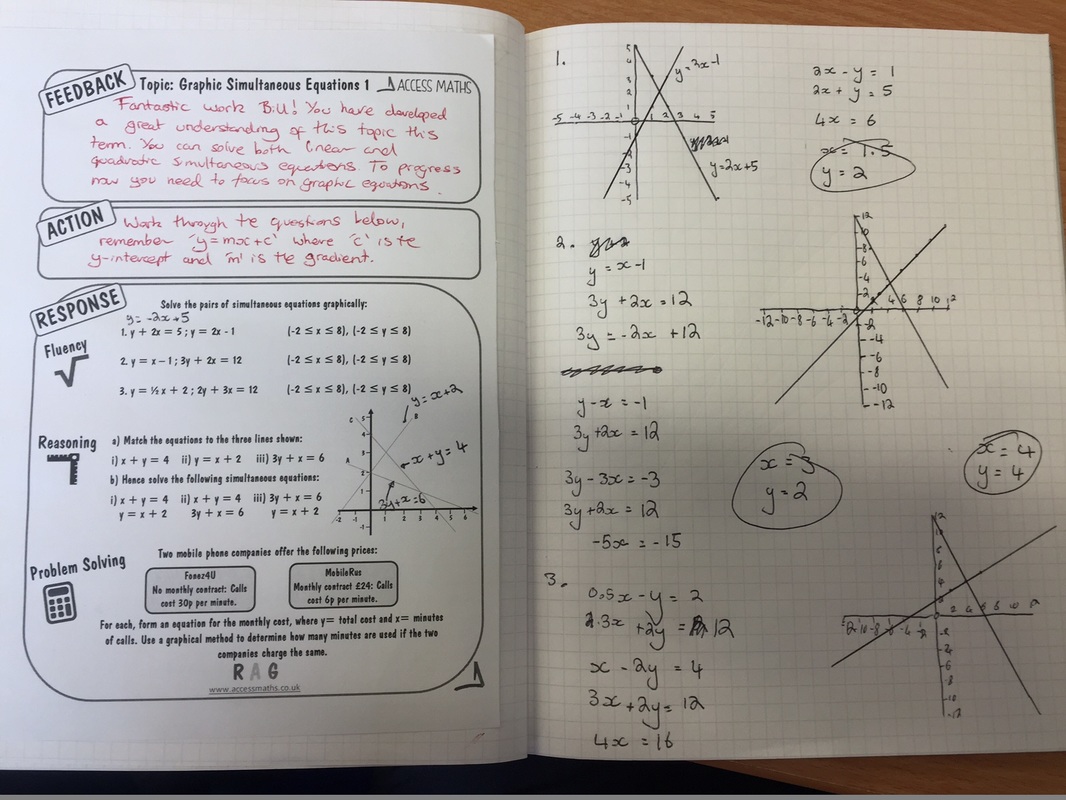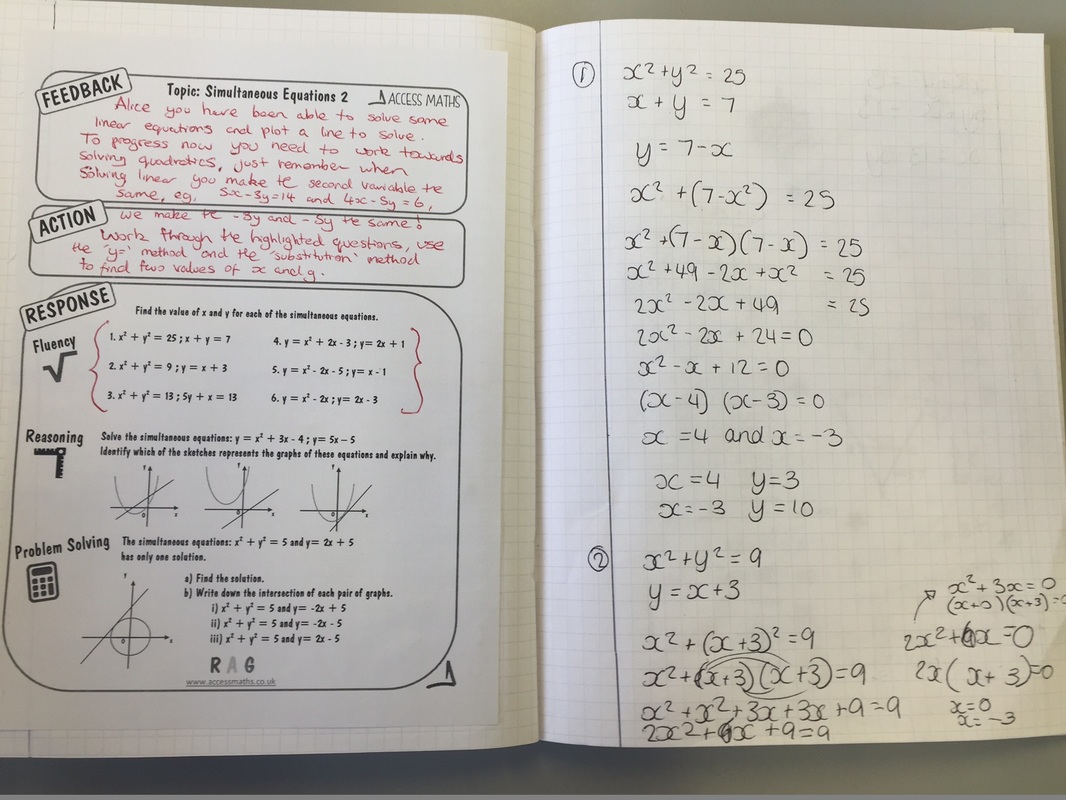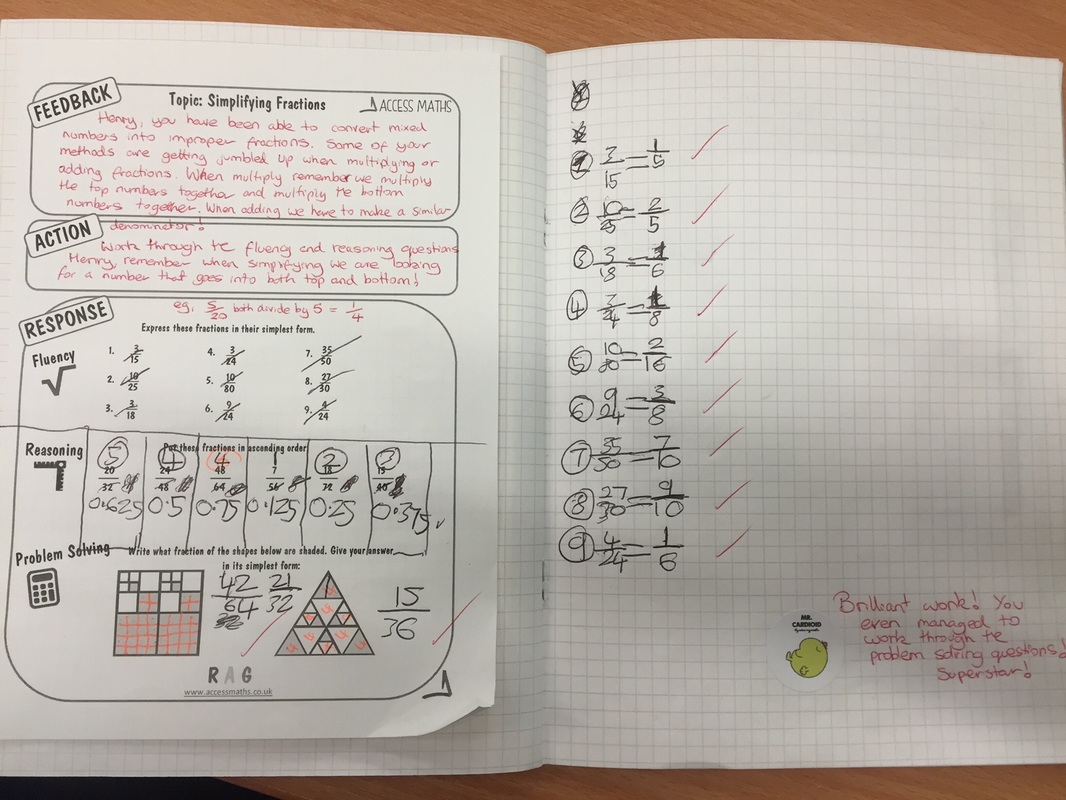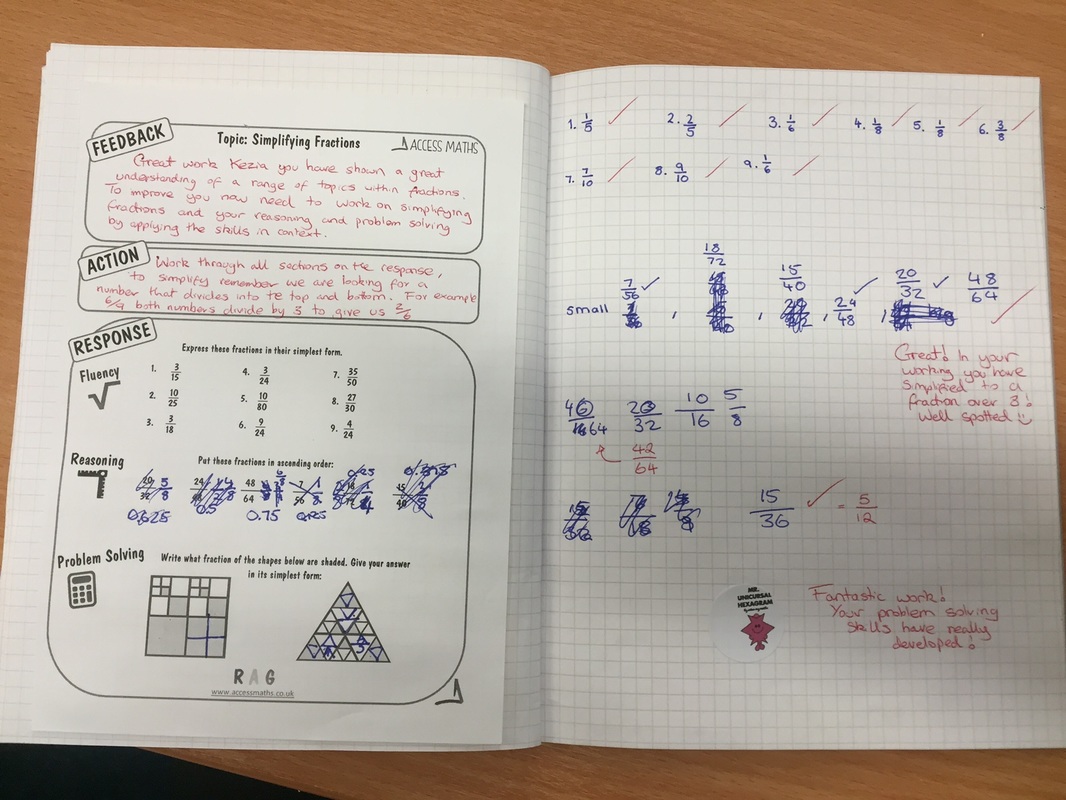|
So after the last post on feedback I recieved a few messages asking about how I was using the feedback sheets in lessons and how I was using them for KS4 so here it is. Part of my focus this year has been developing this process, and there are still some small aspects that I beleive need ironing out but it is currently maneageable and effective which has been my aim from the start. The main thing that I am doing now to gauge what feedback I give is using topic assessments every 2 weeks. The examples shown below are after a 2 week stretch on simultanous equations with a high achieving KS4 set, at the time of the assessment we had covered algebraic linear and quadratic simultaneous equations and done a small amount on graphical linear simultaneous equations. The only feedback I give now is on these assessments, after all if a student gets 20 questions wrong in their books on a particular subtopic and this has helped lead to mastery when completing the assessments, why bother marking all those mistakes when everything is self assessed in class time and they now understand it as proven by the assessment? I am strongly of the opinion that these periods of self assessment are incredibly powerful and I insist that all work must be marked and corrected in class so that I can conduct my AFL during classtime. After the class has done the assessment I get these marked and fedback on for the next upcoming lesson, this particular set took me 1 hour and 33 minutes (I was asked to time it by a member of the department, so no.. I am not that sad), it took me slightly longer than usual as some of the methods and feedback elements were slightly more complex than basic fractions with year 7. Again each memeber of the class recieved written feedback on their own relevent sheet, some had algebraic linear equations, some quadratic focussing on either the 'y=' method or the substitution method when using the equation of a circle, and others had graphical simultaneous equations. So feedback responses were all being targeted at indivudual areas for improvement. Once completed, the next lesson students have around 30 minutes to read through the feedback and complete the relevent rosponse areas, students have questions to work through focusing on fluency, reasoning and problem for each topic. Along with this, each feedback sheet has it's own relevent 'help sheet' that you can see in the pictures below. One thing I found was that giving 32 students a bunch of questions on a topic they couldn't do on the assessment was a recipe for a riot of 'I don't get it', as it was impossible to provide extended feedback for 6 different sub topics beyond the written element in order for them to make a confident start on the questions. If needed students can collect the relevent help sheet and start working straight away. I have found this particularly useful for some of my classes that I have focussed on building resilience, students are now directing themselves towards 'revision material' or 'help sheets' rather than relying on me. Some example pictures shown below: So far this system has been working well, I have run it across all of my year groups a few times now and the quality of the responses has improved tremendously. Students have been more engaged within the lesson and are becoming more and more motivated to improve upon areas they need to develop. One student read their feedback the lesson after the DIRT session last week and said "Sir this has made my week, thank you!". Atleast I know it's being appreciated by some one. 9-1 Feedback Sheets
14 Comments
It's not really something I am fond on putting my marking out into the public domain, so I'll start it off straight away with the reason I feel uncomfortable to do so. I know that my marking isn't yet perfect, although I do beleive I am doing my best at this point in time. I have been constantly re-assessing my feedback this year and refining the way I approach it, earlier in August I had just over 100 students fill in a questionnaire asking them what they thought of the feedback they received in mathematics, and asked them to write in some qualitative feedback. This was actually really useful, and I would definitely recommend trying it out. Ultimately, this has helped lead to where I currently am with my own feedback this new term. As teachers, marking is quite personal, especially if you have spent hours doing it! So having others pass judgement on it is always going to be a tough conversation (if the conversations isn't a positive one anyway).
So first of all, all of my marking tends to take place in class, ALL classwork is marked by students in green pen, there is rarely a task that we ever do in class that we don't get instant feedback on and self assessed in class. I find that it very quickly allows me to undertake my AFL around the room when you can see ticks or crosses very clearly in the students books. So the only part that I actually onduct a detailed mark on is end of topic assessments and teacher assessed homeworks, then finally on student responses to feedback. Fortunately these tend to fall every 12-14 days which falls in line with the schools marking policy of two weeks. Below is a typical topic assessment, this is with a 'bottom set' year 7 class I teach 3 times a week. While marking the assessments I have (for this particular assessment) 5 different feedback sheets in front of me; simplifying fractions, finding fractions of an amount, multiplying/dividing fractions, adding/subtracting fractions, and converting improper fractions and mixed numbers. As I am marking the assessment, I then pick up the sheet which each student needs to improve on and provide their feedback on this particular sheet. At the start of the next lesson students then stick these sheets in on a double page spread and work on their responses on the opposite page. What I had found previously was that writing in a question was taking me an extra few minutes per book, and then once in class it was extremely difficult to ensure that all students had completed that question as one student would finish in a few minutes where as others would need much longer. This is why I have put these new sheets together, it gives students time to consolidate, challenge and extend the topic they struggled on and allows them to work through reasoning and problem solving style questions in line with the new GCSE. Some examples of books from this year 7 class are shown below: So far, after around 9-10 DIRT sessions this term across all my classes, students have been really engaged in these feedback sessions, there is enough work to be getting on with that it allows me to get around the class and provide verbal feedback to those who struggled more than others on particular topics, while those who are happy to work through the whole sheet can move onto all levels of questions and get some challenge on the problem solving questions. I have been dedicating around 30 minutes of a lesson to these DIRT sessions so far and have found this is just enough time that everyone will be able to complete the 'fluency' questions while others are completing all levels of questions. The only written feedback I am now giving is on the 9-1 Feedback Sheets I have been uploading. It's taking me on average 1 hour to mark a set of 30 mini assessments and provide feedback and actions for each student. And this is happening after every topic or series of subtopics, for example my year 9's have been doing algebraic fractions and we have recently done an assessment on simplifying them. Students then had to work on either factorising quadratics, simplifying basic algebraic fractions or simplifying algebraic fractions involving quadratics. See example image below: Anyway that's what I'm doing! If you have been using these in a different way or have any ideas then please let me know! You can access all of these sheets on the link below: 9-1 Feedback Sheets
|
Search for a topic
Categories
All
Archives
May 2018
|
|
Maths Resources @AccessMaths
|
©AccessMaths 2015
|























 RSS Feed
RSS Feed